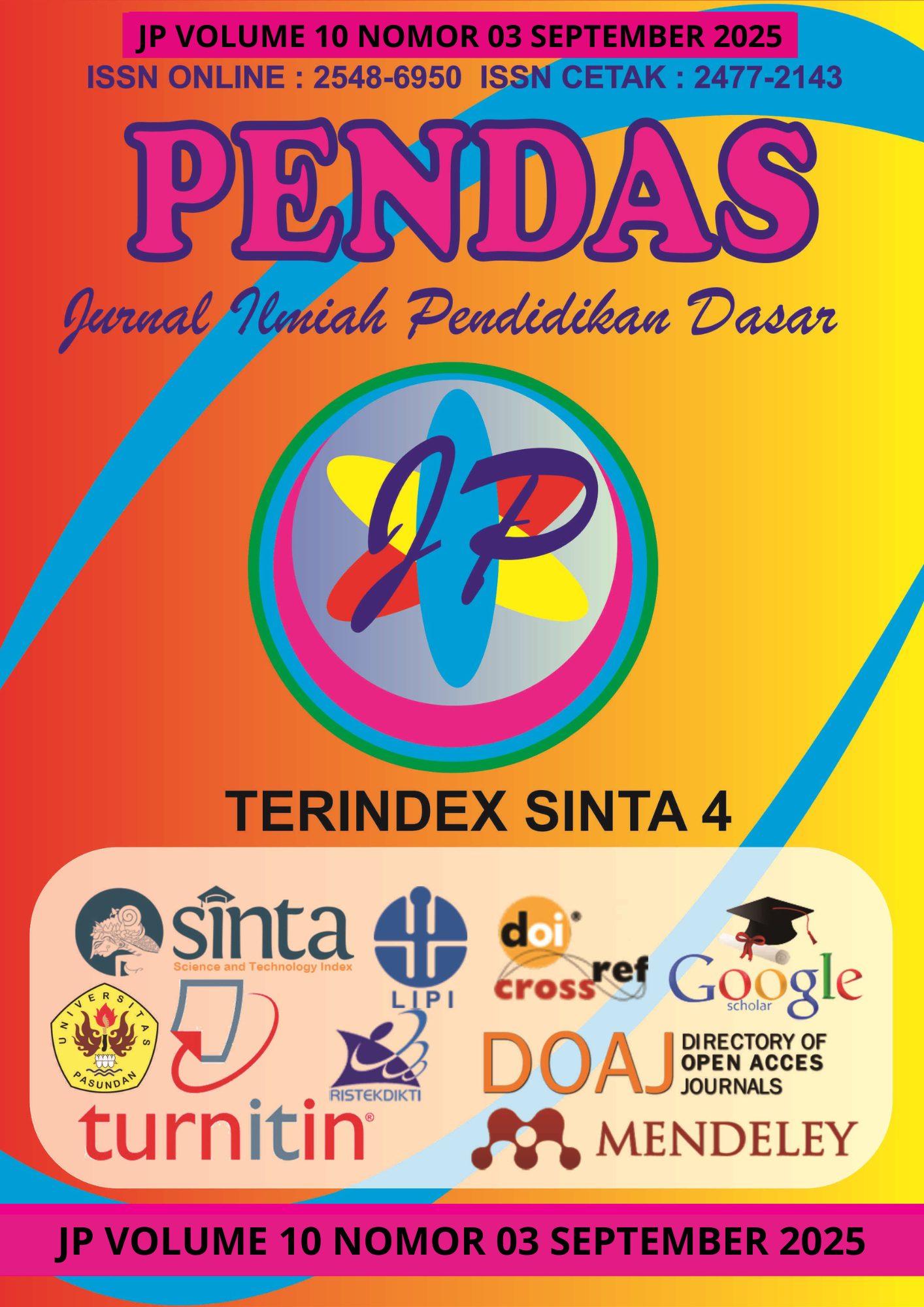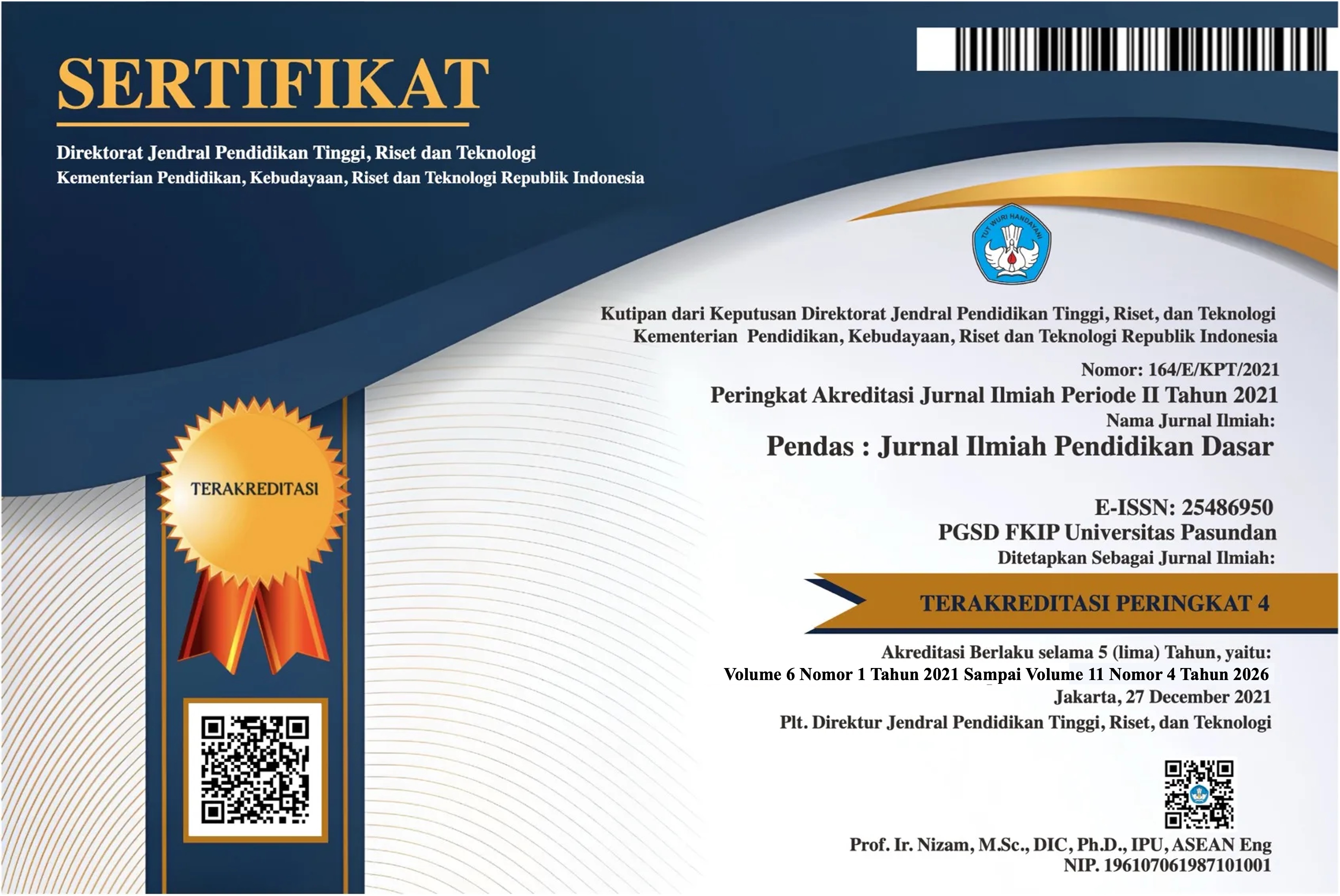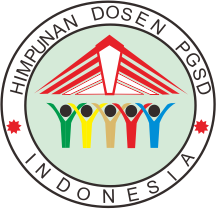PENGARUH MODEL LOK-R BERBANTUAN QUESTION BOX TERHADAP BERPIKIR KRITIS DAN SELF-AWARENESS SISWA SMP
DOI:
https://doi.org/10.23969/jp.v10i3.29209Keywords:
critical thinking, LOK-R model, mathematics learning, question box, self awarenessAbstract
This study investigates the effect of the LOK-R instructional model—which consists of Literacy, Orientation, Collaboration, and Reflection—combined with the Question Box media on students’ mathematical critical thinking skills and self-awareness. The research employed a quasi-experimental design using a posttest-only control group approach. The participants were three eighth-grade classes: the first experimental group was taught using the LOK-R model with the Question Box media, the second group received instruction with the LOK-R model only, and the control group was taught using Direct Instruction. Data were collected using essay tests to assess critical thinking and Likert-scale questionnaires to measure self-awareness. A MANOVA analysis yielded a Wilks’ Lambda value of 0.254 with a significance level of 0.000, indicating a statistically significant multivariate effect of the instructional model. The highest mean critical thinking score was observed in the first experimental group (76.13; SD = 4.864), followed by the second experimental group (67.47), and the control group (58.58). These findings demonstrate that integrating the LOK-R model with the Question Box media is more effective in enhancing both critical thinking and self-awareness among students.
Downloads
References
Ahmed, A. A. A., Al-Shami, A. M., Jamshed, S., & Nahas, A. R. F. (2019). Development of Questionnaire on Awareness and Action Towards Symptoms and Risk Factors of Heart Attack and Stroke Among a Malaysian Population. BMC Public Health, 19(1). https://doi.org/10.1186/s12889-019-7596-1
Bai, B., Shen, B., & Wang, J. (2021). Impacts of social and emotional learning (SEL) on English learning achievements in Hong Kong secondary schools. Language Teaching Research, 28(3), 1176–1200. https://doi.org/10.1177/13621688211021736
Brookhart, S. M. (2010). How to Assess Higher-Order Thinking Skills in Your Classroom. In Ascd. ASCD. http://www.ascd.org/Publications/Books/Overview/How-to-Assess-Higher-Order-Thinking-Skills-in-YourClassroom.aspx
Çutuk, Z. A., & Türk, T. (2019). The Mindful Coping Scale: The Validity and Reliability of Turkish Version. Ahi Evran Üniversitesi Sosyal Bilimler Enstitüsü Dergisi, 5(2), 220–236. https://doi.org/10.31592/aeusbed.591719
Damayanti, S., Asbari, M., Setiawan, D., & Saputra, M. S. (2023). Emotional intelligence : mengapa ei lebih penting daripada iq? In Literaksi: Jurnal Manajemen Pendidikan (Vol. 01, Issue 02). Gramedia. https://literaksi.org/index.php/jmp/article/view/280
Dangin, D., Setyawan, A. H., & Hartati, E. (2023). Metacognitive Awareness and Self-Regulated Learning toward Students’ Academic Achievement: Prediction study. International Journal of Social Science and Human Research, 6(11). https://doi.org/10.47191/ijsshr/v6-i11-24
Dewi, N. M. R., & Widiana, I. W. (2020). Question Box Dalam Pembelajaran IPS Dengan Model Creative Problem Solving Meningkatkan Hasil Belajar IPS Siswa. Jurnal Pedagogi Dan Pembelajaran, 3(2), 164. https://doi.org/10.23887/jp2.v3i2.25262
Facione, P. a. (2011). Critical Thinking : What It Is and Why It Counts. Insight Assessment, 1(ISBN 13: 978-1-891557-07-1.), 1–28. https://www.insightassessment.com/CT-Resources/Teaching-For-and-About-Critical-Thinking/Critical-Thinking-What-It-Is-and-Why-It-Counts/Critical-Thinking-What-It-Is-and-Why-It-Counts-PDF
Hwang, S., Kim, B., & Kang, H.-S. (2021). The Development of Emotional Intelligence Scale in Sport Coaching. Korean Journal of Sport Science, 126–137. https://doi.org/10.24985/kjss.2021.32.1.126
Manesh, A. D., Yazdankhahfard, M., Motamed, N., & Pouladi, S. (2024). Design and Psychometrics of the Awareness and Self-Care Performance Questionnaire of Diabetic Patients in the Coronavirus Disease 2019 Pandemic. 12(2), 76–84. https://doi.org/10.34172/jhad.92386
Nur, T. D., Corebima, A. D., Zubaidah, S., Ibrohim, I., & Saefi, M. (2023). Learning Biology Through Thinking Empowerment by Questioning: The Effect on Conceptual Knowledge and Critical Thinking. Participatory Educational Research, 10(1), 122–139. https://doi.org/10.17275/per.23.7.10.1
OECD. (2023). Annex B1: Results for countries and economies. In PISA 2022 Results (Volume I): Excellence and Equity in Education: Vol. I (Issue Volume I). https://www.oecd-ilibrary.org/education/pisa-2015-results-volume-i_9789264266490-en
Retnawati, H., Djidu, H., Kartianom, K., Apino, E., & Anazifa, R. D. (2018). Teachers’ Knowledge About Higher-Order Thinking Skills and Its Learning Strategy. Problems of Education in the 21st Century, 76(2), 215–230. https://doi.org/10.33225/pec/18.76.215
Romli, S., Suhandi, A., Muslim, M., & Kaniawati, I. (2024). Research trends in the development of learning models oriented to increasing scientific literacy: A systematic literature review. Indonesian Journal of Science and Mathematics Education, 7(1), 66–79. https://doi.org/10.24042/ijsme.v5i1.20517
Sari, B. Y. P., & Sayekti, I. C. (2023). Talking Stick Learning Model Assisted by Media Question Box: Effectiveness on Science Learning Outcomes in Elementary Schools. Journal of Education Research and Evaluation, 7(1), 35–42. https://doi.org/10.23887/jere.v7i1.58196
Sari, B. Y. P., Sayekti, I. C., Purnama Sari, B. Y., & Candra Sayekti, I. (2023). Talking Stick Learning Model Assisted by Media Question Box: Effectiveness on Science Learning Outcomes in Elementary Schools. Journal of Education Research and Evaluation, 7(1), 35–42. https://doi.org/10.23887/jere.v7i1.58196
Widyawati, S., Putra, F. G., & Mufita, H. (2024). Enhancing mathematical representation ability: Innovative DMR learning model with question box media integration. Jurnal Math Educator Nusantara: Wahana Publikasi Karya Tulis Ilmiah Di Bidang Pendidikan Matematika, 10(1), 1–11. https://doi.org/10.29407/jmen.v10i1.21444
Yao, J., Zhang, Z. X., & Liu, L. A. (2021). When there is no zopa: Mental fatigue, integrative complexity, and creative agreement in negotiations. Negotiation and Conflict Management Research, 14(2), 111–130. https://doi.org/10.1111/ncmr.12178
Zulherman, Z., Iba, K., Paramita, A. A., Supriansyah, S., & Aji, G. B. (2021). The Influence of The Question Box Media Assisted Teams Games Tournament Model on Science Learning Outcomes at Elementary School. Sekolah Dasar: Kajian Teori Dan Praktik Pendidikan, 88. https://doi.org/10.17977/um009v30i12021p088
Downloads
Published
Issue
Section
License
Copyright (c) 2025 Pendas : Jurnal Ilmiah Pendidikan Dasar

This work is licensed under a Creative Commons Attribution 4.0 International License.



















